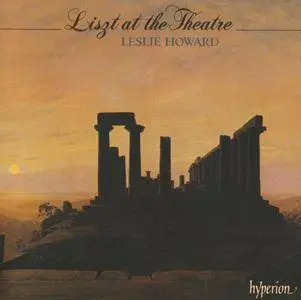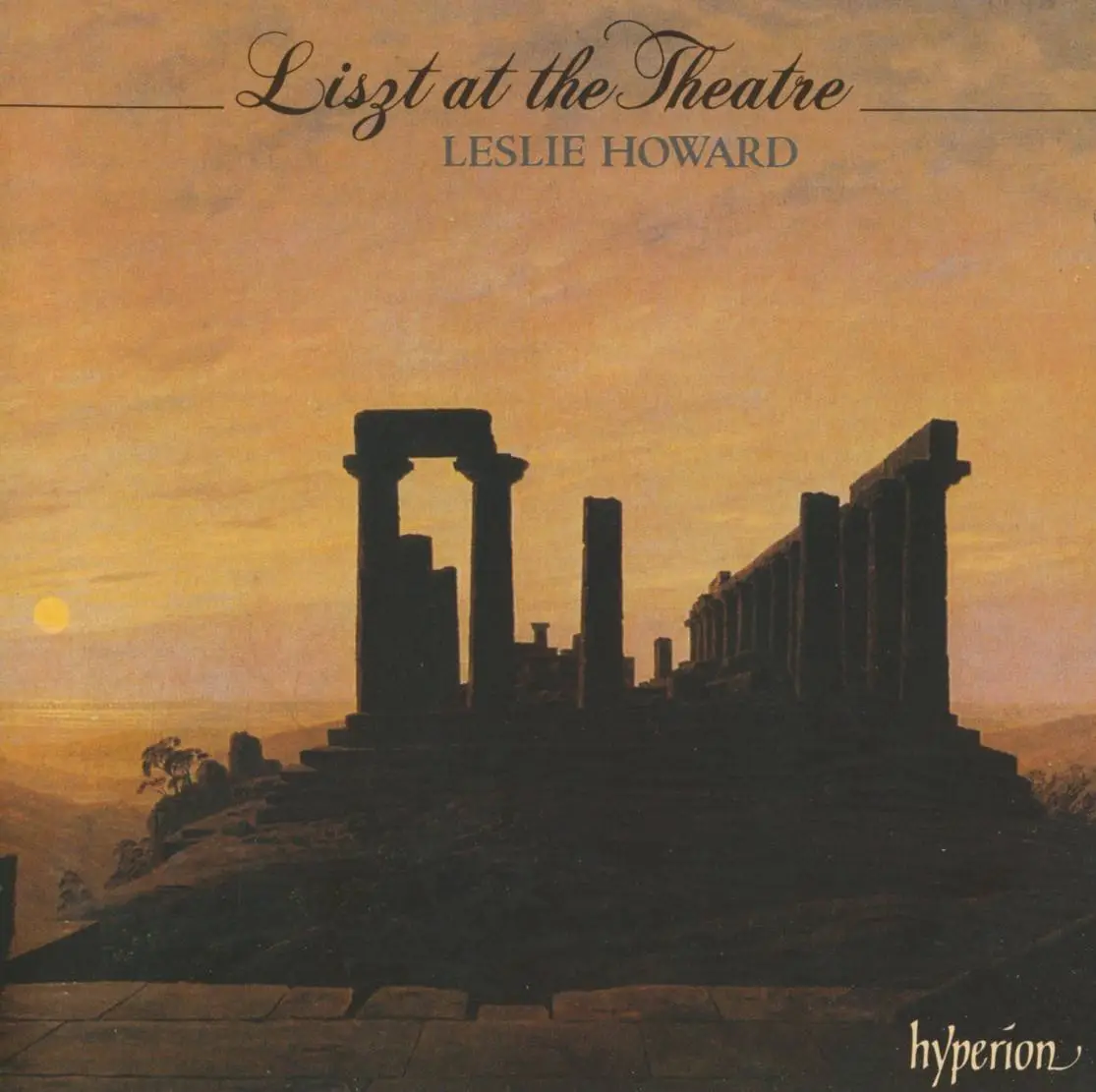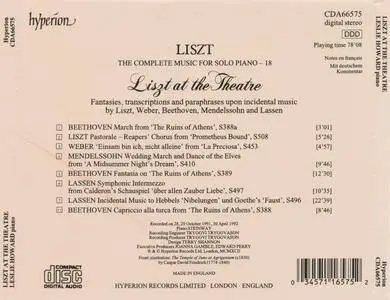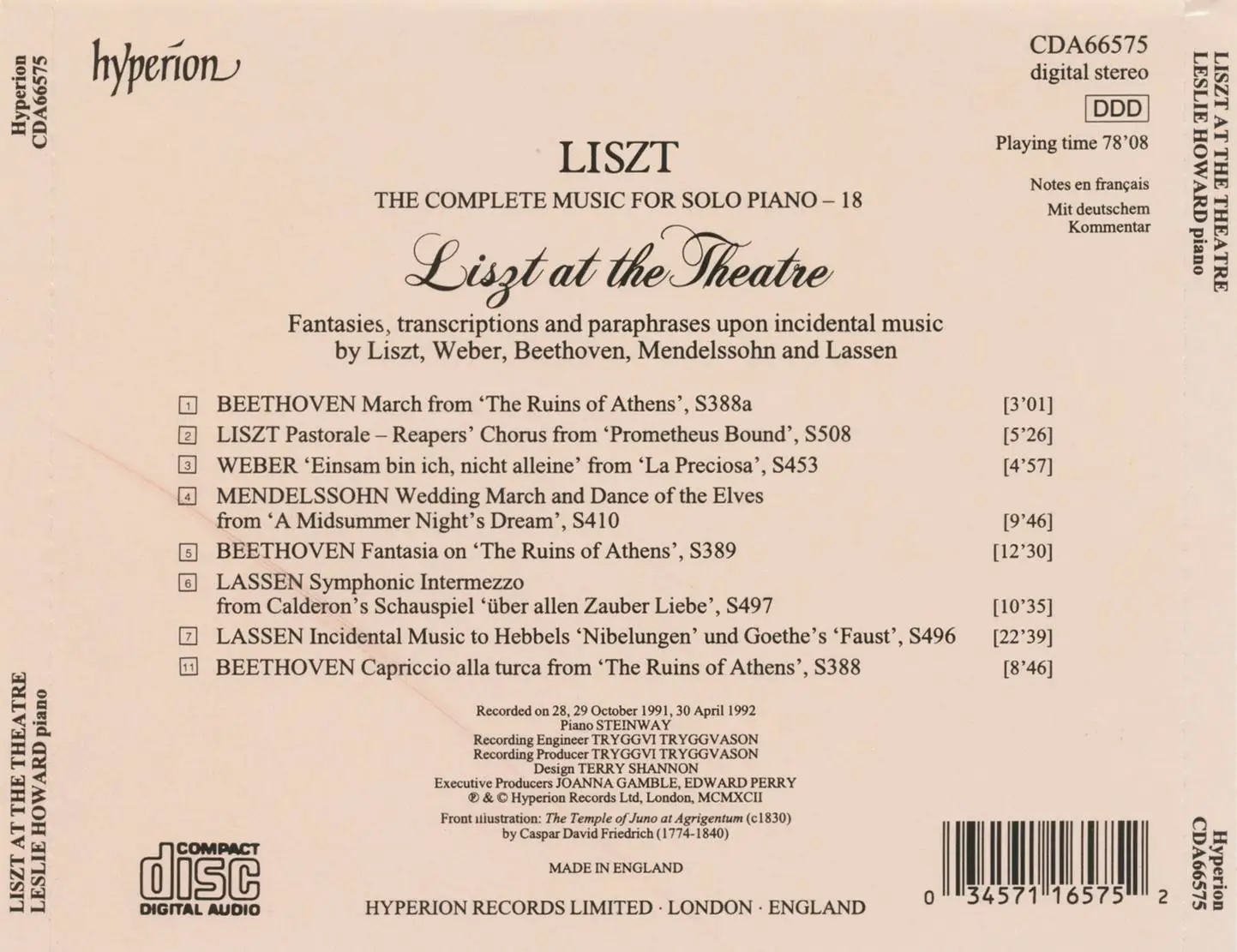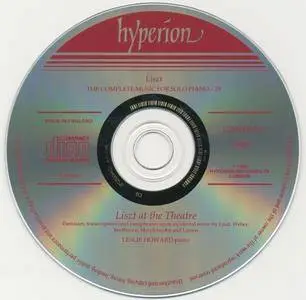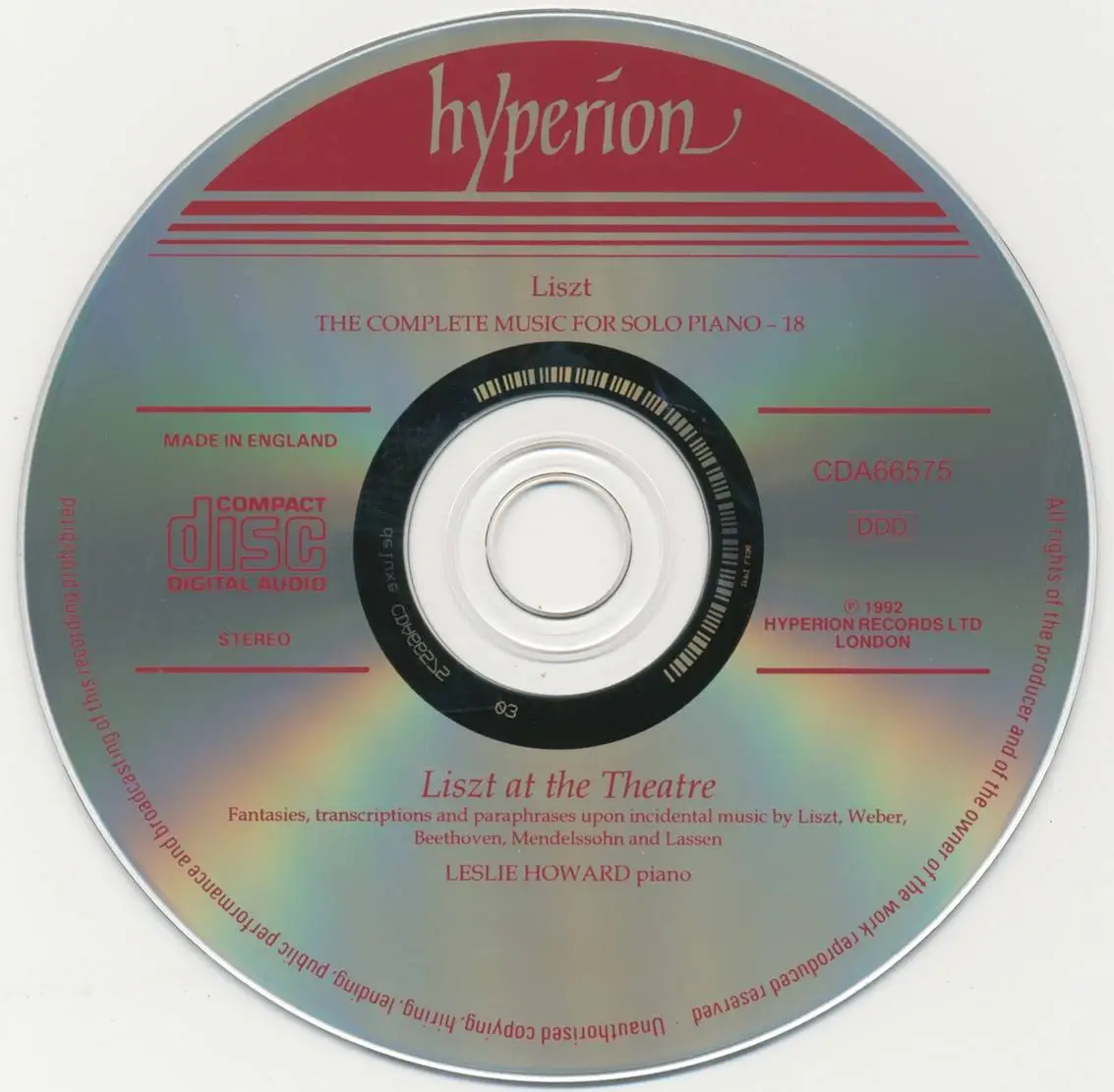Franz Liszt - Liszt at the Theatre - Leslie Howard (1992) {Hyperion CDA66575}
EAC rip (secure mode) | FLAC+CUE+LOG -> 229 Mb | MP3 @320 -> 182 Mb
Full Artwork @ 300 dpi (png) -> 18 Mb | 5% repair rar
© 1992 Hyperion Records | CDA66575
Classical / Solo Piano
Whilst Liszt’s piano music derived from music for plays is a much smaller body of work than his catalogue of operatic pieces, the approach in his methods of composition, elaboration and transcription remains broadly the same. As far as present Liszt scholarship permits one ever to be categorical, this recording contains all of Liszt’s works in this genre.
The quite extensive scores for the theatre commonly written in the nineteenth century eventually overpowered both the plays they accompanied and the time limit for an audience’s concentration. Today few would relish an uncut performance of Ibsen’s Peer Gynt given with the entire Grieg score if they knew beforehand that the evening would take at least one hour longer than Götterdämmerung, and it has been only rarely that Mendelssohn’s Shakespearean efforts have been produced in tandem with the complete play. But much incidental music—which can take the form of overture, dances, songs, intermezzos or entr’actes, choruses or melodramas, as well as shorter flourishes and fanfares, entrance and exit fragments—has always had an independent life in the concert hall, and for Liszt, to whom the propagation of all kinds of music was a sacred duty, selected several works for re-working as recital pieces.
For some reason the piano transcription of the ever-popular Turkish March from The Ruins of Athens disappeared from view, to be replaced in pianists’ affections by the well-known transcription by Anton Rubinstein. Liszt’s version—every bit as interesting—is one of his rarest works. The identical pages stand at the head of the score of Capriccio alla turca, a much more extensive piece in Liszt’s virtuoso manner, in which the March (No 4 in Beethoven’s score) is succeeded by the Dervishes’ Chorus (No 3 in Beethoven’s score; also, at one time, known in a piano transcription by Saint-Saëns) in a section marked Andante fantastico, full of diabolical trills. Eventually the March returns, much transformed, and both themes are used to produce a triumphant coda. Possibly because of its difficulty, the Capriccio gave way to Liszt’s last work on the same material, the Fantasie, which started life as a work for piano and orchestra but which was substantially revised and reissued together with versions for solo piano, piano duet, and two pianos. The Fantasie begins with a transcription of the orchestral part of the March and Chorus (which form Beethoven’s No 6, and which Beethoven reissued as opus 124 with minor changes for the music to Die Weihe des Hauses—‘The Consecration of the House’) which breaks out with a cadenza in octaves into a much more fantastic working of the material, which then subsides into the Dervishes’ Chorus. From this point, there are many resemblances to the Capriccio but the atmosphere is rather more controlled and the fireworks held in abeyance until the coda. There, closing passages of the March and Chorus lead into a final peroration upon the other two themes.
Liszt’s own contribution to the literature of incidental music comprises just two works—Vor hundert Jahren, which is an overture-cum-melodrama for spoken voice and orchestra for a play by Halm (S347, unpublished to date), and an overture and choruses to Herder’s play Prometheus Bound, which was among those works too large to be accommodated on the same evening as the play for which it was intended. In the end, Liszt revised the Prometheus work thoroughly, transforming the overture into what we now know as the independent symphonic poem Prometheus. The symphonic poem could still serve as an overture to the choruses, which were now punctuated with a poetic oration by Richard Pohl to get through the gist of Herder’s play in indecent haste to allow room for well over an hour of music. Amongst the choral sections of the work, the Reapers’ Chorus proved instantly popular and Liszt issued versions of it for piano solo and for piano duet. Among an output so vast as Liszt’s it is perhaps an inevitable pity that this attractive trifle has fallen into oblivion.
Quite why Liszt described Weber’s music to Preciosa as an opera must remain a mystery—indeed, the shape of the piece is not greatly different from Liszt’s Prometheus Choruses—but we can only thank him for bringing this charming aria to our attention.
At one time, Liszt’s often witty interpretation of the famed Mendelssohn Wedding March was a regular recital war-horse. It could be that familiarity with Mendelssohn’s original—not to mention innumerable versions of bits of it encountered in so many parish churches and Hollywood films—has stifled interest. But the idea of performing this work, along with Liszt’s fiendish arrangement of the Introduction to Act III and Bridal March from Lohengrin at a marriage ceremony remains a Schwarzenplan of the present writer. Liszt furnishes Mendelssohn’s work with a ghostly, almost satirical introduction, and then a rather light-hearted version of the main material before he gets to the piece proper. Then the main section is subject to variation whenever it reappears. Mendelssohn’s first interlude is faithfully transcribed, but the F major section with its flowing theme ends up flowing into very strange harmonic waters in order to prepare for the interpolation of the Dance of the Elves. Liszt is loth to let go the elvish music, so he allows it to permeate the return of the march before the triumphant coda is given a triumphalist transcription.
Liszt’s elaborations of three works by Eduard Lassen call for some special comment. Lassen (1830–1904) succeeded Liszt as Kapellmeister at the Weimar court in 1858, and held the post until 1895. As well as the works presented here, Liszt made transcriptions of two of Lassens’s songs. Lassen, who was an ardent Lisztophile and Wagnerite (as one can instantly tell from his music) was responsible for several of the chamber-music versions of Liszt’s later works which have come down to us as Liszt’s own because he used Lassen’s version as the basis for his own revisions. Now sadly relegated to one of the footnotes to the history of music, Lassen is almost unrepresented in print or on record except in Liszt’s transcriptions.
As the title suggests, the Symphonic Intermezzo is a large-scale orchestral work. Its long-flowing melodies are constructed from smaller cells, and Liszt sometimes sequentially extends the material in the way characteristic of his later works. The proud opening music leads to an Andante amoroso and an absolutely splendid and memorable melody which is worked out at some length. The final section of the work, Feierlich ruhig (‘Proudly peaceful’), opens with a series of chords and arpeggios which recall the prelude to Parsifal, and this passage occurs four times in different keys, alternating with fragments of the Andante and rounded off with a bell-like coda that refers to the opening as well as to the bell-motif from Parsifal.
Liszt used the fifth and eighth numbers of the eleven pieces in Lassen’s music to Hebbel’s drama Nibelungen, which has some story-line in common with Wagner’s ‘Ring’. In both cases, Liszt extends the original material. Kriemhild, somewhat transformed into Gutrune in Wagner, is memorable in the Nibelungenlied for despatching the villain Hagen after the death of her husband Siegfried. Bechlarn (Pöchlarn in the Nibelungenlied) is the location where the noble minstrel Volker sings a public serenade of tribute to Gotelind. Lassen’s Serenade, in Liszt’s hands, is of a touching and naive simplicity.
Goethe’s masterpiece has attracted a great many composers, and Lassen’s contribution is a substantial one. His Faust score has some sixty-four numbers to it. The ‘Easter Hymn’ (Lassen’s Part 1, No 2), the hearing of which interrupts Faust’s resolve to kill himself, is straightforwardly transcribed, but the Hoffest (‘Court Celebration’) is Liszt’s own combination of two numbers (2 and 3) from Part Two of Lassen’s work. Here Liszt greatly varies and elaborates Lassen’s themes in an introductory march and a very gallant and ornamental Polonaise.
Hyperion INFO
Personnel:
Leslie Howard (piano)
tracklist:
01 - Marche turque des Ruines d'Athenes, S388a (Beethoven)
02 - Pastorale - Schnitter-Chor aus dem Entfesselten Prometheus, S508
03 - 'Einsam bin ich, nicht alleine' aus der Oper Preciosa, S453 (Weber)
04 - Hochzeitsmarsch und Elfenreigen aus dem Sommernachtstraum, S410 (Mendelssohn)
05 - Fantasie uber Motive aus Beethovens Ruinen von Athen, S389
06 - Symphonisches Zwischenspiel {Intermezzo} zu Calderons Schauspiel 'Uber allen Zauber Liebe', S497 (Lasse)
07 - Aus der Musik von E. Lassen zu H. Nibelungen und G. Faust, S496 - 'Nibelungen' I. Hagen und Kriemhild
08 - Aus der Musik von E. Lassen zu H. Nibelungen und G. Faust, S496 - 'Nibelungen'. II. Bechlarn
09 - Aus der Musik von E. Lassen zu H. Nibelungen und G. Faust, S496 - 'Faust'. I. Osterhymne
10 - Aus der Musik von E. Lassen zu H. Nibelungen und G. Faust, S496 - 'Faust'. II. Hoffest. Marsch und Polonaise
11 - Capriccio alla turca sur des motifs de Beethoven 'Ruines d'Athenes', S388
Exact Audio Copy V1.0 beta 3 from 29. August 2011
EAC extraction logfile from 20. February 2013, 20:21
Leslie Howard / Liszt - Liszt at the Theatre
Used drive : hp BD RW BD-5750H Adapter: 0 ID: 1
Read mode : Secure
Utilize accurate stream : Yes
Defeat audio cache : Yes
Make use of C2 pointers : No
Read offset correction : 48
Overread into Lead-In and Lead-Out : No
Fill up missing offset samples with silence : Yes
Delete leading and trailing silent blocks : No
Null samples used in CRC calculations : Yes
Used interface : Native Win32 interface for Win NT & 2000
Gap handling : Appended to previous track
Used output format : User Defined Encoder
Selected bitrate : 128 kBit/s
Quality : High
Add ID3 tag : No
Command line compressor : C:\Program Files (x86)\Audio\Exact Audio Copy\Flac\flac.exe
Additional command line options : -8 -V -T "ARTIST=%artist%" -T "TITLE=%title%" -T "ALBUM=%albumtitle%" -T "DATE=%year%" -T "TRACKNUMBER=%tracknr%" -T "TOTALTRACKS=%numtracks%" -T "GENRE=%genre%" -T "ALBUMARTIST=%albumartist%" -T "ALBUM ARTIST=%albumartist%" -T "COMMENT=EAC Secure Mode, Test & Copy, AccurateRip, FLAC -8" %source%
TOC of the extracted CD
Track | Start | Length | Start sector | End sector
––––––––––––––––––––––––––––-
1 | 0:00.32 | 3:02.13 | 32 | 13694
2 | 3:02.45 | 5:26.62 | 13695 | 38206
3 | 8:29.32 | 4:59.70 | 38207 | 60701
4 | 13:29.27 | 9:51.45 | 60702 | 105071
5 | 23:20.72 | 12:36.60 | 105072 | 161831
6 | 35:57.57 | 10:42.10 | 161832 | 209991
7 | 46:39.67 | 5:30.68 | 209992 | 234809
8 | 52:10.60 | 5:14.00 | 234810 | 258359
9 | 57:24.60 | 3:44.05 | 258360 | 275164
10 | 61:08.65 | 8:14.17 | 275165 | 312231
11 | 69:23.07 | 8:46.08 | 312232 | 351689
Track 1
Filename C:\AUDIO\Liszt - Liszt at the Theatre (1992) [FLAC] {Howard, Hyperion CDA66575} {CPM 18}\01 - Marche turque des Ruines d'Athenes, S388a (Beethoven).wav
Pre-gap length 0:00:02.32
Peak level 68.8 %
Extraction speed 10.1 X
Track quality 100.0 %
Test CRC FF7260F0
Copy CRC FF7260F0
Accurately ripped (confidence 2) [CA4E921F] (AR v1)
Copy OK
Track 2
Filename C:\AUDIO\Liszt - Liszt at the Theatre (1992) [FLAC] {Howard, Hyperion CDA66575} {CPM 18}\02 - Pastorale - Schnitter-Chor aus dem Entfesselten Prometheus, S508.wav
Pre-gap length 0:00:00.58
Peak level 51.6 %
Extraction speed 11.4 X
Track quality 100.0 %
Test CRC 1CA40459
Copy CRC 1CA40459
Accurately ripped (confidence 2) [CE0F225A] (AR v1)
Copy OK
Track 3
Filename C:\AUDIO\Liszt - Liszt at the Theatre (1992) [FLAC] {Howard, Hyperion CDA66575} {CPM 18}\03 - 'Einsam bin ich, nicht alleine' aus der Oper Preciosa, S453 (Weber).wav
Pre-gap length 0:00:00.50
Peak level 28.4 %
Extraction speed 12.3 X
Track quality 100.0 %
Test CRC 3048882C
Copy CRC 3048882C
Accurately ripped (confidence 2) [F78361B2] (AR v1)
Copy OK
Track 4
Filename C:\AUDIO\Liszt - Liszt at the Theatre (1992) [FLAC] {Howard, Hyperion CDA66575} {CPM 18}\04 - Hochzeitsmarsch und Elfenreigen aus dem Sommernachtstraum, S410 (Mendelssohn).wav
Pre-gap length 0:00:02.60
Peak level 100.0 %
Extraction speed 13.8 X
Track quality 99.9 %
Test CRC 53A721F6
Copy CRC 53A721F6
Accurately ripped (confidence 2) [A05A075F] (AR v1)
Copy OK
Track 5
Filename C:\AUDIO\Liszt - Liszt at the Theatre (1992) [FLAC] {Howard, Hyperion CDA66575} {CPM 18}\05 - Fantasie uber Motive aus Beethovens Ruinen von Athen, S389.wav
Pre-gap length 0:00:05.42
Peak level 73.5 %
Extraction speed 16.2 X
Track quality 100.0 %
Test CRC 45A55059
Copy CRC 45A55059
Accurately ripped (confidence 2) [C5CE4230] (AR v1)
Copy OK
Track 6
Filename C:\AUDIO\Liszt - Liszt at the Theatre (1992) [FLAC] {Howard, Hyperion CDA66575} {CPM 18}\06 - Symphonisches Zwischenspiel {Intermezzo} zu Calderons Schauspiel 'Uber allen Zauber Liebe', S497 (Lasse).wav
Pre-gap length 0:00:06.52
Peak level 71.6 %
Extraction speed 17.6 X
Track quality 100.0 %
Test CRC B78CB3C9
Copy CRC B78CB3C9
Accurately ripped (confidence 2) [49494A45] (AR v1)
Copy OK
Track 7
Filename C:\AUDIO\Liszt - Liszt at the Theatre (1992) [FLAC] {Howard, Hyperion CDA66575} {CPM 18}\07 - Aus der Musik von E. Lassen zu H. Nibelungen und G. Faust, S496 - 'Nibelungen' I. Hagen und Kriemhild.wav
Pre-gap length 0:00:06.62
Peak level 44.9 %
Extraction speed 18.1 X
Track quality 100.0 %
Test CRC 5EA680EB
Copy CRC 5EA680EB
Accurately ripped (confidence 2) [DAC1BE07] (AR v1)
Copy OK
Track 8
Filename C:\AUDIO\Liszt - Liszt at the Theatre (1992) [FLAC] {Howard, Hyperion CDA66575} {CPM 18}\08 - Aus der Musik von E. Lassen zu H. Nibelungen und G. Faust, S496 - 'Nibelungen'. II. Bechlarn.wav
Peak level 32.6 %
Extraction speed 18.5 X
Track quality 100.0 %
Test CRC 61C5A9E7
Copy CRC 61C5A9E7
Accurately ripped (confidence 2) [6BEA3BEB] (AR v1)
Copy OK
Track 9
Filename C:\AUDIO\Liszt - Liszt at the Theatre (1992) [FLAC] {Howard, Hyperion CDA66575} {CPM 18}\09 - Aus der Musik von E. Lassen zu H. Nibelungen und G. Faust, S496 - 'Faust'. I. Osterhymne.wav
Pre-gap length 0:00:03.25
Peak level 50.5 %
Extraction speed 15.8 X
Track quality 99.9 %
Test CRC EE352E6A
Copy CRC EE352E6A
Accurately ripped (confidence 2) [ECF4DDB3] (AR v1)
Copy OK
Track 10
Filename C:\AUDIO\Liszt - Liszt at the Theatre (1992) [FLAC] {Howard, Hyperion CDA66575} {CPM 18}\10 - Aus der Musik von E. Lassen zu H. Nibelungen und G. Faust, S496 - 'Faust'. II. Hoffest. Marsch und Polonaise.wav
Pre-gap length 0:00:02.38
Peak level 75.2 %
Extraction speed 19.9 X
Track quality 100.0 %
Test CRC 3A97D508
Copy CRC 3A97D508
Accurately ripped (confidence 2) [3C4BB686] (AR v1)
Copy OK
Track 11
Filename C:\AUDIO\Liszt - Liszt at the Theatre (1992) [FLAC] {Howard, Hyperion CDA66575} {CPM 18}\11 - Capriccio alla turca sur des motifs de Beethoven 'Ruines d'Athenes', S388.wav
Pre-gap length 0:00:02.65
Peak level 88.9 %
Extraction speed 20.4 X
Track quality 100.0 %
Test CRC B5E68A45
Copy CRC B5E68A45
Cannot be verified as accurate (confidence 6) [421F9911], AccurateRip returned [B7DFA14A] (AR v2)
Copy OK
10 track(s) accurately ripped
1 track(s) could not be verified as accurate
Some tracks could not be verified as accurate
No errors occurred
End of status report
==== Log checksum 0E71ACABD732C1C449ADF96962C4CDF2C9F3EBD423DA5BE07B12E36D64196B80 ====
EAC extraction logfile from 20. February 2013, 20:21
Leslie Howard / Liszt - Liszt at the Theatre
Used drive : hp BD RW BD-5750H Adapter: 0 ID: 1
Read mode : Secure
Utilize accurate stream : Yes
Defeat audio cache : Yes
Make use of C2 pointers : No
Read offset correction : 48
Overread into Lead-In and Lead-Out : No
Fill up missing offset samples with silence : Yes
Delete leading and trailing silent blocks : No
Null samples used in CRC calculations : Yes
Used interface : Native Win32 interface for Win NT & 2000
Gap handling : Appended to previous track
Used output format : User Defined Encoder
Selected bitrate : 128 kBit/s
Quality : High
Add ID3 tag : No
Command line compressor : C:\Program Files (x86)\Audio\Exact Audio Copy\Flac\flac.exe
Additional command line options : -8 -V -T "ARTIST=%artist%" -T "TITLE=%title%" -T "ALBUM=%albumtitle%" -T "DATE=%year%" -T "TRACKNUMBER=%tracknr%" -T "TOTALTRACKS=%numtracks%" -T "GENRE=%genre%" -T "ALBUMARTIST=%albumartist%" -T "ALBUM ARTIST=%albumartist%" -T "COMMENT=EAC Secure Mode, Test & Copy, AccurateRip, FLAC -8" %source%
TOC of the extracted CD
Track | Start | Length | Start sector | End sector
––––––––––––––––––––––––––––-
1 | 0:00.32 | 3:02.13 | 32 | 13694
2 | 3:02.45 | 5:26.62 | 13695 | 38206
3 | 8:29.32 | 4:59.70 | 38207 | 60701
4 | 13:29.27 | 9:51.45 | 60702 | 105071
5 | 23:20.72 | 12:36.60 | 105072 | 161831
6 | 35:57.57 | 10:42.10 | 161832 | 209991
7 | 46:39.67 | 5:30.68 | 209992 | 234809
8 | 52:10.60 | 5:14.00 | 234810 | 258359
9 | 57:24.60 | 3:44.05 | 258360 | 275164
10 | 61:08.65 | 8:14.17 | 275165 | 312231
11 | 69:23.07 | 8:46.08 | 312232 | 351689
Track 1
Filename C:\AUDIO\Liszt - Liszt at the Theatre (1992) [FLAC] {Howard, Hyperion CDA66575} {CPM 18}\01 - Marche turque des Ruines d'Athenes, S388a (Beethoven).wav
Pre-gap length 0:00:02.32
Peak level 68.8 %
Extraction speed 10.1 X
Track quality 100.0 %
Test CRC FF7260F0
Copy CRC FF7260F0
Accurately ripped (confidence 2) [CA4E921F] (AR v1)
Copy OK
Track 2
Filename C:\AUDIO\Liszt - Liszt at the Theatre (1992) [FLAC] {Howard, Hyperion CDA66575} {CPM 18}\02 - Pastorale - Schnitter-Chor aus dem Entfesselten Prometheus, S508.wav
Pre-gap length 0:00:00.58
Peak level 51.6 %
Extraction speed 11.4 X
Track quality 100.0 %
Test CRC 1CA40459
Copy CRC 1CA40459
Accurately ripped (confidence 2) [CE0F225A] (AR v1)
Copy OK
Track 3
Filename C:\AUDIO\Liszt - Liszt at the Theatre (1992) [FLAC] {Howard, Hyperion CDA66575} {CPM 18}\03 - 'Einsam bin ich, nicht alleine' aus der Oper Preciosa, S453 (Weber).wav
Pre-gap length 0:00:00.50
Peak level 28.4 %
Extraction speed 12.3 X
Track quality 100.0 %
Test CRC 3048882C
Copy CRC 3048882C
Accurately ripped (confidence 2) [F78361B2] (AR v1)
Copy OK
Track 4
Filename C:\AUDIO\Liszt - Liszt at the Theatre (1992) [FLAC] {Howard, Hyperion CDA66575} {CPM 18}\04 - Hochzeitsmarsch und Elfenreigen aus dem Sommernachtstraum, S410 (Mendelssohn).wav
Pre-gap length 0:00:02.60
Peak level 100.0 %
Extraction speed 13.8 X
Track quality 99.9 %
Test CRC 53A721F6
Copy CRC 53A721F6
Accurately ripped (confidence 2) [A05A075F] (AR v1)
Copy OK
Track 5
Filename C:\AUDIO\Liszt - Liszt at the Theatre (1992) [FLAC] {Howard, Hyperion CDA66575} {CPM 18}\05 - Fantasie uber Motive aus Beethovens Ruinen von Athen, S389.wav
Pre-gap length 0:00:05.42
Peak level 73.5 %
Extraction speed 16.2 X
Track quality 100.0 %
Test CRC 45A55059
Copy CRC 45A55059
Accurately ripped (confidence 2) [C5CE4230] (AR v1)
Copy OK
Track 6
Filename C:\AUDIO\Liszt - Liszt at the Theatre (1992) [FLAC] {Howard, Hyperion CDA66575} {CPM 18}\06 - Symphonisches Zwischenspiel {Intermezzo} zu Calderons Schauspiel 'Uber allen Zauber Liebe', S497 (Lasse).wav
Pre-gap length 0:00:06.52
Peak level 71.6 %
Extraction speed 17.6 X
Track quality 100.0 %
Test CRC B78CB3C9
Copy CRC B78CB3C9
Accurately ripped (confidence 2) [49494A45] (AR v1)
Copy OK
Track 7
Filename C:\AUDIO\Liszt - Liszt at the Theatre (1992) [FLAC] {Howard, Hyperion CDA66575} {CPM 18}\07 - Aus der Musik von E. Lassen zu H. Nibelungen und G. Faust, S496 - 'Nibelungen' I. Hagen und Kriemhild.wav
Pre-gap length 0:00:06.62
Peak level 44.9 %
Extraction speed 18.1 X
Track quality 100.0 %
Test CRC 5EA680EB
Copy CRC 5EA680EB
Accurately ripped (confidence 2) [DAC1BE07] (AR v1)
Copy OK
Track 8
Filename C:\AUDIO\Liszt - Liszt at the Theatre (1992) [FLAC] {Howard, Hyperion CDA66575} {CPM 18}\08 - Aus der Musik von E. Lassen zu H. Nibelungen und G. Faust, S496 - 'Nibelungen'. II. Bechlarn.wav
Peak level 32.6 %
Extraction speed 18.5 X
Track quality 100.0 %
Test CRC 61C5A9E7
Copy CRC 61C5A9E7
Accurately ripped (confidence 2) [6BEA3BEB] (AR v1)
Copy OK
Track 9
Filename C:\AUDIO\Liszt - Liszt at the Theatre (1992) [FLAC] {Howard, Hyperion CDA66575} {CPM 18}\09 - Aus der Musik von E. Lassen zu H. Nibelungen und G. Faust, S496 - 'Faust'. I. Osterhymne.wav
Pre-gap length 0:00:03.25
Peak level 50.5 %
Extraction speed 15.8 X
Track quality 99.9 %
Test CRC EE352E6A
Copy CRC EE352E6A
Accurately ripped (confidence 2) [ECF4DDB3] (AR v1)
Copy OK
Track 10
Filename C:\AUDIO\Liszt - Liszt at the Theatre (1992) [FLAC] {Howard, Hyperion CDA66575} {CPM 18}\10 - Aus der Musik von E. Lassen zu H. Nibelungen und G. Faust, S496 - 'Faust'. II. Hoffest. Marsch und Polonaise.wav
Pre-gap length 0:00:02.38
Peak level 75.2 %
Extraction speed 19.9 X
Track quality 100.0 %
Test CRC 3A97D508
Copy CRC 3A97D508
Accurately ripped (confidence 2) [3C4BB686] (AR v1)
Copy OK
Track 11
Filename C:\AUDIO\Liszt - Liszt at the Theatre (1992) [FLAC] {Howard, Hyperion CDA66575} {CPM 18}\11 - Capriccio alla turca sur des motifs de Beethoven 'Ruines d'Athenes', S388.wav
Pre-gap length 0:00:02.65
Peak level 88.9 %
Extraction speed 20.4 X
Track quality 100.0 %
Test CRC B5E68A45
Copy CRC B5E68A45
Cannot be verified as accurate (confidence 6) [421F9911], AccurateRip returned [B7DFA14A] (AR v2)
Copy OK
10 track(s) accurately ripped
1 track(s) could not be verified as accurate
Some tracks could not be verified as accurate
No errors occurred
End of status report
==== Log checksum 0E71ACABD732C1C449ADF96962C4CDF2C9F3EBD423DA5BE07B12E36D64196B80 ====
===


